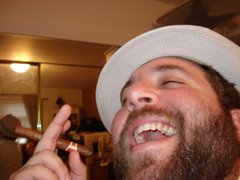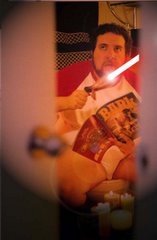Lucha Libre is professional wrestling that is enjoyed by people all over Latin America. It literally means "Free fight" or "Free-for-all fight" but this is a bit of a misnomer. It is highly choreographed, more so even than American pro wrestling. It is different than Greco-Roman wrestling which relies on grapples and American Pro wrestling which is mostly defined by its throw maneuvers such as the pile driver or sleeper hold. No, Lucha Libre is an acrobatic aerial display more akin to Gymnastics and ballet than the other forms of wrestling. But this isn't what most people think of when they think of Lucha Libre, they think of the masks and the larger than life characters.
The mask is something that resonates in the mind of Latinos because of our ancestry that includes the various indigenous peoples of the Americas and the African cultures that came to Latin America through the slave trade. In the cultures of the Aztec, Maya, Inca and many others masks were used in their rituals in which they invoked their gods and in which they played out the myths and rites that kept the universe going. The African gods were likewise honored and celebrated by the slaves who brought their faith in their gods such as Chango, Yemaya, Obatala and others. When a dancer or shaman put on the face of the god, spirit, or demon he BECAME that entity. It was a way to bring the transcendental to the temporal. The god was there in your midst, and you could touch him and ask their help. This tradition lives on in the masks of the Luchadors. They don't talk about their contracts or alliances built on economic entities like they do on U.S. Wrestling shows. The Luchador plays out the eternal battle between good and evil. The Technicos (the technicians, or Good Guys) are locked in a constant struggle with the Rudos (rude boys or Bad Guys). The Technicos often take up the cause of the people both in and out of the ring. They build hospitals, try to get out the vote, and participate in literacy programs. The greatest luchador of all time, El Santo, set up a college fund to send underprivileged kids from poor neighborhoods to the university or like the true story that "Nacho Libre" is based on in which a monk really did wrestle to raise money for an orphanage. While it may seem odd to us in the United States to think that Hulk Hogan or Triple H would do such things in Latin America it is par for the course. The wrestlers are the modern incarnations of those immortal beings that fought for the people back in olden times. The rudos often represent corrupt crime lords, politicians, the police and other people within the society that seek to do them harm. They are not just vague representations of evil, but concrete examples of the evil within the society. Lucha Libre is highly moral and things are black and white with no shades of grey. You are either on the side of the people and good or on the side of the powerful and evil.
In the United States we tend to think of wrestling as a novelty or farce. We, unjustly, stereotype fans of wrestling as being white trash hicks. All it is is the male version of the "stories" the soap operas. But in Latin America Lucha Libre is a serious sport, one that in enjoyed by all levels of society. The wrestler is a respected athlete and a representative of national honor. The Luchador represents all that is best in the Latino should he is brave, passionate, and strong. He is the archetype of the man we all wish to be. We Latinos have had to fight for every shred of dignity we have. We've been conquered and exploited since the beginning by the Spanish, the Americans, the Soviets and others. Latino men have had to defend their nation and their family when it was threatened by these conquerors and exploiters. This is what the Luchador is, the champion of the people. Though the matches do happen in the big arenas in the big cities, they are more often in smaller venues in working class neighborhoods. Everyday people can don the mask and try their luck in the ring. If they win they may win a few bucks and at least some form of immortality.
The interesting thing is that it isn't the man behind the mask that matters but the character. It is common for the character to be passed down through generations as father passes on the mantle of El Santo, Rey Mysterio, Blue Demon, La Parka or others. When they go out in public they wear the mask and try not to show their faces to anyone but friends and family. These characters live forever because the symbol or image of the character cannot die. It is like Santa Claus, it doesn't matter that the guy in the mall isn't the real Santa he is A Santa. I could don the mask of Rey Mysterio and go in as a representative of the character and avatar of his essence.
The power of this phenomenon goes far beyond the borders of Latin America. Luchadors have infiltrated American Wrestling in which you can see Rey Mysterio, Jr. battling against Stone Cold Steve Austin. I was once on a ferry going from Athens to one of the islands in the Aegean sea and I was wearing my El Santo as a cowboy shirt. The two Greek guys behind the counter started yelling and pointing at my chest "El Santo! My Hero! El Santo!". I learned that El Santo's films are extremely popular in Greece, the birthplace of wrestling. The films made by El Santo, Blue Demon and others have brought Lucha Libre to many people who would never have seen it before. Usually they fight against Dracula or the Wolf Man or other such evil doers. On my netflix list El Santo and Blue Demon Vs. The Amazon women has "Very Long Wait" next to it due to their popularity. In my own comedy troupe Ubertoast, we have a pair of Mexican Wrestlers beat up some famous asswipe that has outlived their 15 minutes of fame.
When El Santo died in 1984 his funeral was attended by the president of Mexico and many other dignitaries. His coffin was taken through the streets and thousands of people came out to see him away. He was buried wearing his trademark silver mask and cape. A year later his son was back wearing the mask. El Santo cannot die, he is immortal.
If you go to Mexico journey into a market and pick up a mask. They usually cost about 5 bucks. Put it on and see how you feel. Maybe you will feel like fighting for justice...or maybe just like a jackass wearing a shiny mask in a Mexican market. You be the judge.



No comments:
Post a Comment